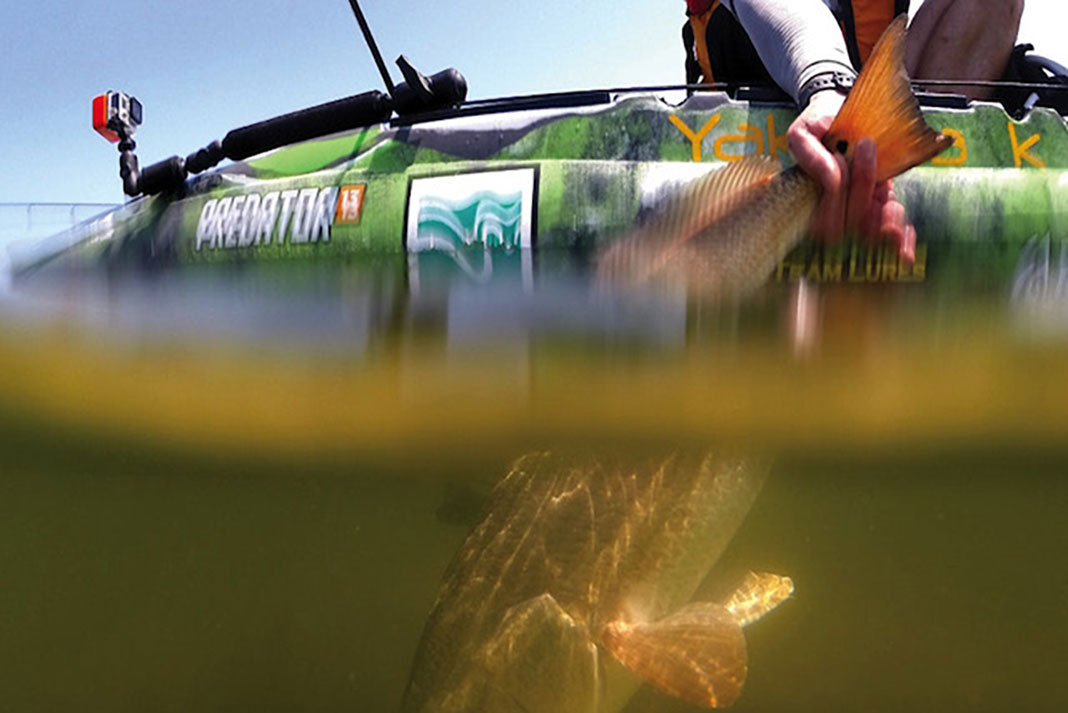Dave Narr yelled and pointed 20 yards off his bow, “There they are!” I looked into the silty-green water expecting to see a big school of 40-pound red drum. Nothing. “Where?” Jeff was already making a cast. As soon as his lure hit the water, big reds exploded in every direction. You see, I was looking for fish with my eyes while Jeff was using side-scan sonar. All the preparation, travel, paddling, searching, sweating, cursing and suffering would have been for nothing, if it hadn’t been for Jeff’s side-scan unit. I ordered one the next day.
Getting to Know Side-Scan Sonar
Before making the big leap I called Bill Carson, a product manager at Humminbird, and asked him to explain the difference between regular sonar and side-view. “Traditional sonar uses a round ceramic disk in the transducer to shoot a beam of sound beneath the boat,” he explained. The beam bounces off anything hard and returns an image of structure and fish.

“Side-scan sonar uses a long, thin transducer that shoots a beam up to 150 feet to each side of the boat,” he continued, “You can see fish and structure, even paddle strokes.” Carson told me of new, smaller side-view units that draw less electricity; a big concern for kayak anglers with limited power capacity.
Carson suggested I speak to Old Town/Ocean Kayak pro Richie Bekolay, who uses a side-view unit to target offshore and inshore species out of Navarre Beach, Florida.
Side Imaging Sonar in Salt and Freshwater
Bekolay told me his first time using a side-scan unit he was fishing for big red drum. “I marked the fish 50 feet to the right, made a cast and hooked up immediately,” he bragged. Bekolay uses the unit to track down everything from largemouth to king mackerel. “I can see creek beds, depressions, humps, rocks and fish.”
When he spots something interesting, Bekolay can mark it on his GPS display. This comes in handy when he’s trolling offshore. “I will troll while using Side Imaging to locate structure that would be perfect for bottom fish such as snapper and grouper.”
In freshwater, Bekolay uses the unit to find fish in heavy cover. “I can actually see bass holding under docks,” he says. Bekolay suggests taking a new unit for a test drive in clear water with visible structure. “It takes some practice to identify structure and fish,” he says. “The more I study the details, the more I can recognize what I’m marking on the machine.”
Another tip: Bekolay suggests mounting the transducer so it can be raised and lowered. “The transducer needs to hang below the hull,” he explains. He can get a full day out of a 12-volt, 7-amp rechargeable battery. “Battery life depends on how many tasks the unit is processing,” Bekolay says.
Don’t Look Askance at Side-Scan Sonar
Fifty years ago, the U.S. military developed side-scan sonar to detect enemy submarines and submerged mines; now kayak anglers can use the same technology to detect fish and structure. “Side-scan saves time and energy,” Bekolay says, “when every paddle stroke counts.”
This article was first published in the Summer/Fall 2015 issue of Kayak Angler. Subscribe to Kayak Angler Magazine’s print and digital editions, or browse the archives.
A side-scan transducer sticks below the boat for the best view of fish and structure. | Feature photo: Richie Bekolay







I recently went on a trip down south and the guide I hired referred to his Livescope as “video-gaming”. It’s not the same, but similar – and I’ll be honest I was skeptical. I thought it would completely take the challenge out of fishing, however, we were looking for pods of baitfish over 60′ – 80′ of water in a massive reservoir… and while this tool helped us find the locations to fish faster, it didn’t take the fun and challenge out of it. I’m sure this is a hot-button topic all over but I can see the application for these tools – but also, the potential for abuse.